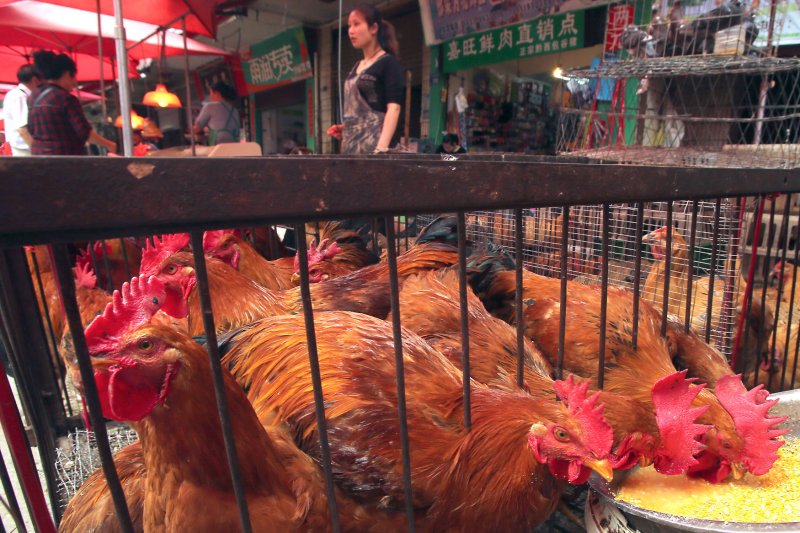The higher than expected demand for soybeans in China may be partly explained by an increase in the nation's poultry production, as chickens are fed soybean meal. File Photo by Stephen Shaver/UPI |
License Photo
EVANSVILLE, Ind., Aug. 2 (UPI) -- China's appetite for soybeans to feed livestock seems to be holding remarkably strong amid reports that the nation has lost 20 to 70 percent of its hogs to African swine fever.
"Fifty percent of China's soybean meal went to feed hogs" before the outbreak, said Arlan Suderman, the Chief Commodities Economist at INTL FCStone, which provides commodities market analysis.
"Right now, our team on the ground in China estimates hog feeding is down 45 percent," Suderman said. "So, the soybean market should be down almost [25 percent]. But it's not."
The reduction appears to be closer to 10 percent, he said.
Other groups are hearing similar reports.
Several Chinese companies that produce soybean meal told Iowa farmers in China on a trade mission late last month that their production had not decreased at all since the outbreak.
"We tried to pin some of the companies down on the impact African swine fever had on the soybean demand," said Kirk Leeds, CEO of the Iowa Soybean Association, which organized the trip. "The two we talked to said the reduced demand on the pork side has been filled with increased demand from poultry."
Leeds was quick to add that he suspects that statement is not entirely accurate.
"We know that some of the crushers are not operating at full capacity," he said.
But there is no denying that China is buying far more soybeans than industry experts expected.
This robust demand may be partly explained by an increase in the nation's poultry production.
Reports from the USDA and Chinese media indicate that as pork prices are skyrocketing, more consumers are buying chicken and duck. Poultry producers are responding to the demand by expanding their production.
One duck farm in China's Shandong province, for example, aims to raise its output by 30 percent this year, the South China Morning Post reported July 26.
"The market prospects are very good now because of African swine fever," Wang Shuhong, the chairman of Shenghe, a firm that sells ducklings for slaughter, told the publication.
Chickens and ducks cannot account for all the soy currently produced, Suderman said. The most China can increase its poultry production in 2019 is about 8 percent, given the country's cage capacity, according to the USDA.
That's a small fraction of the lost pigs.
Something else is sustaining the Chinese demand, Suderman said.
"What's probably happening is fear of the disease means that pig farmers are feeding more soybean meal to their hogs," Suderman said.
Before the outbreak, many pig farmers fed their animals with what's known as "swill," which is essentially table scraps. Many of those scraps included pork that, if infected, could transmit the African swine fever virus. Many credit this practice for enabling the disease to spread so quickly across the country.
Pork is the most popular meat in China, and before last year's African swine fever outbreak, the nation raised more than half of the pigs on the planet -- some 710 million animals.
Reports vary as to how many hogs have been lost to the disease.
The Chinese Ministry of Agriculture and Rural Affairs said in April that the herd had dropped by 22 percent. Rabobank, a Netherland-based international bank that focuses on the rural food and agriculture sector, estimates the current loss at more than 40 percent. INTL FC Stone also estimates roughly 40 percent.
African swine fever is deadly to pigs (it does infect humans). There is no vaccine or treatment for the disease, leaving culling and biosecurity as the only options for containment.
"We've been especially concerned about the impact African swine fever is having on soybean demand," said Lindsay Greiner, an Iowa farmer and president of the Iowa Soybean Association, who traveled to China this month. "We've been surprised because the demand for soybeans is still strong."
American soy growers welcome the news as it indicates that Chinese buyers may still purchase their soybeans should a trade truce be reached between their two countries.
China was buying around 30 percent of America's crop before that government slapped a high retaliatory tariff -- a tax paid by importers -- on U.S. beans last summer, making them too expensive for Chinese importers to buy.
There now is a huge surplus of American beans, which has driven the price to its lowest in more than a decade. If more beans are planted this spring, that surplus will continue to grow, which could force the price down get more -- and make it all the more difficult to recover.
Soybean prices Friday opened at $8.49 per bushel. A year ago, the price was more than $10.
"From the meetings we've had in the last couple of days, I'm encouraged that they still want to do business with us," Greiner said of China. "Our relationships are still strong. If we are competitive, they'll still want to do business."















